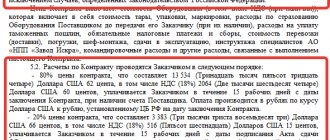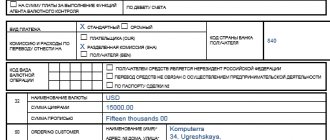Currency transactions in accounting in 2021 - 2021
In accordance with the above PBU, in 2021-2021, as in previous periods, currency transactions in accounting are reflected exclusively in rubles. This accounting provision does not apply to accounting for currency transactions related to:
- with the recalculation of financial reporting indicators, which are submitted in rubles, into foreign currency according to the requirements of foreign creditors;
- when compiling consolidated accounting, when the parent company processes the accounting of dependent institutions located abroad.
You can get more detailed information about currency transactions in our material “Currency transactions: concept, types, classifications” .
For conversion, the exchange rate of the Central Bank of Russia is used on the date that corresponds to the nature of the transaction. We will tell you more about the procedure for converting into rubles when accounting for foreign exchange transactions.
How to convert currency to rubles
To account for transactions in foreign currency, the date on which you should take the Central Bank exchange rate and convert the currency into rubles is very important. As already mentioned, in Russia, accounting for foreign exchange transactions is carried out exclusively in rubles, and since exchange rates are constantly changing, it is important to know the “correct” moment of converting currency indicators into rubles.
Thus, in order to be reflected in accounting and reporting, the cost values of liabilities and assets of a legal entity expressed in foreign currency, as well as the amount of reserves in foreign currency, must be converted into rubles.
In accounting for foreign exchange transactions, only the official exchange rate of the Central Bank of a given currency to the ruble is used to convert cost indicators into Russian rubles. The exception is cases when, in order to convert the value of a monetary obligation or a tangible asset into rubles, a special law or agreement establishes a different rate at which the amount payable must be recalculated.
The date of conversion of currency indicators into rubles is different for each operation. Most often, the date of conversion at the official exchange rate is the moment when the business operation is carried out. In the case where over the course of a month (or a shorter time period) an enterprise carries out a large number of similar transactions in foreign currency, and the official exchange rate has not undergone significant changes, it is possible to keep records of transactions in foreign currency of this type at the rate averaged over a given period of time.
PBU 3/2006 clearly defines all the moments when currency amounts should be converted into rubles:
- On the date of the business operation (when cash flows), as well as on the reporting date (balances at the cash desk/account), it is necessary to convert into rubles all cash/non-cash currency at the cash desk/on the foreign exchange account. Also, in a number of situations, the value of funds may be recalculated as the exchange rate changes.
- Cash/non-cash currency is recalculated at the rate existing at the reporting date in order to reflect the data in the financial statements.
- As of the date of the business transaction, the value of fixed assets, intangible and other non-current assets accepted for accounting, as well as the value of inventories and other assets, with the exception of cash, is recalculated.
- On the date of recognition of foreign currency income or expenses, they are recalculated into rubles. As for the date of recognition of travel expenses, it coincides with the moment of approval of the traveler’s advance report.
- On the date of recognition of costs that form the cost of fixed assets, intangible and other non-current assets, the amount of investments in foreign currency in these non-current assets is recalculated into Russian rubles.
- If an enterprise has received an advance payment in the form of a deposit or an advance payment, then these funds are accounted for in accounting in Russian rubles at the exchange rate at the time of receipt of the specified amounts.
- If the prepayment was paid by the company (in the form of transfer of a deposit or payment of an advance against the delivery of assets or for expected expenses), then this payment will be reflected in the accounting records in rubles at the rate prevailing on the date of payment.
After non-current assets, transferred or received advances have been reflected in accounting, their value is not recalculated when the exchange rate changes.
Read about what points you need to pay special attention to when organizing accounting for foreign economic activity in the article “Features of accounting for foreign economic activity .
How to determine the date?
Federal Law 402 (Article 12) states that all accounting and reporting objects must be expressed exclusively in rubles, and assets calculated in foreign currency must be recalculated into rubles. According to PBU, such recalculation is carried out at the rate of the Central Bank or by agreement of the parties to the transaction.
The exchange rate of any monetary unit constantly fluctuates, therefore, determining the correct date of conversion is one of the main tasks of an accountant.
PBU sets the date depending on the nature of the transaction:
- cash, banking volumes of currency - at the time of transactions and at the reporting date, as well as following changes in the exchange rate (if necessary);
- for reporting, all currencies: non-cash, cash, are recalculated on the reporting date;
- Intangible assets, fixed assets, inventories, other non-monetary assets - as of the date of the transaction and their registration;
- foreign currency income and expenses - as of the date of recognition (travel expenses in foreign currency are recalculated on the date of signing the advance report);
- costs for VNA - as of the date of recognition of costs that determine these assets, their value.
In addition, when receiving a foreign currency advance payment or deposit, the amount is taken into account at the exchange rate at the time of its receipt, and when paid - on the date when the payment was made.
According to PBU, paragraph 10, non-current and other assets, except cash, as well as advances and prepayments after being reflected in accounting, are not subject to recalculation due to exchange rate fluctuations.
Important! If the official exchange rate changes insignificantly and a large number of similar currency transactions take place, the average rate for a month or for a shorter period can be used for recalculation (clause 6 of PBU 3/2006).
What is exchange rate difference
The difference in rubles that arises when recalculating the currency value of assets and liabilities on different dates is called exchange rate. The exchange rate difference at the end of the reporting period relates to the financial result of the company, with the exception of the difference that is calculated on constituent deposits. In the latter case, the difference in rubles arises during the time interval between the founders’ decision to make a contribution in foreign currency and the very moment the founder pays the contribution. Such exchange rate differences do not affect the company’s financial results, but change the amount of additional capital.
Also included in the company’s additional capital is the exchange rate difference that arises when converting into rubles the tangible assets and monetary liabilities of a legal entity used to carry out business activities abroad. Exchange differences in this case can be attributed to the financial result in the form of adding part of the additional capital in the event of termination of activities abroad.
In all other cases, the exchange rate difference is credited to the financial result, reducing or increasing its total value.
Exchange differences arise on the following transactions:
- In case of partial or full repayment of debts by debtors or creditors in foreign currency. In this case, recalculation is carried out at the time of payment, if the debt was previously reflected in accounting at a different rate (the cost in rubles was calculated on the day of the transaction or recalculated on the last reporting date).
- When converting assets in the form of non-cash or cash into rubles.
The article “What is the responsibility for illegal currency transactions?” will introduce you to the types of currency violations and penalties for committing them.
Formation of exchange rate differences
In the process of carrying out economic activities, the exchange rate in relation to the national currency may change, which entails the formation of exchange rate differences. For example:
When selling goods to a foreign buyer (actual shipment), its cost was 150 US dollars. On the day of shipment the rate was 55.4. The accounting records reflected revenue in the amount of:
$150 \cdot 55.4 = $8310 rub.
On the date of crediting payment to the goods received, the US dollar exchange rate was 54.9.
The accounting records reflected the buyer's payment:
$150 \cdot 54.9 = $8235 rub.
Thus, a negative exchange rate difference was formed:
$8310 - 8235 = 75$ rub.
This difference is taken into account:
- for accounting – as part of other expenses;
- for tax accounting – as part of non-operating expenses.
Similarly, a positive exchange rate difference may arise (if at the time of payment by the buyer, the exchange rate has increased). In this case, positive exchange rate differences are taken into account:
- for accounting – as part of other income;
- for tax accounting – as part of non-operating income.
Note 2
There should be increased attention to exchange rate differences, since their size ultimately determines the tax base for calculating income tax. Therefore, it is necessary to monitor the accuracy of exchange rates and timely reflection in accounting of all transactions with funds in foreign currency.
Payments in foreign currency and reporting
The statements indicate exclusively the ruble equivalent of the value of the company's assets, existing liabilities and reserves (including those used/located abroad).
If in the country where a Russian company operates, it is required to prepare reports in the currency of that state, then the reports are also prepared in foreign currency.
The financial statements reflect those cost values that are indicated in the accounting. In most cases, the conversion of the currency value into rubles is carried out at the time of the transaction, but there are situations when it is necessary to make a conversion at the reporting date.
The accounting records reveal the amounts of exchange rate differences:
- formed when converting into rubles the currency value of assets and liabilities for which it is required to pay in foreign currency;
- when recalculating the currency value of assets and liabilities for which payment will be made in rubles;
- credited to accounting accounts, which do not take into account financial results.
The official exchange rate in rubles established by the Central Bank on the reporting date is also reflected in the financial statements. If a rate other than the official rate of the Central Bank of the Russian Federation is established (by agreement or law), then this information is also reflected in the reporting.
Find out about the latest changes in currency legislation from this publication.
Cash accounting
The financial statements must strictly indicate the calculation of foreign currencies in relation to the Russian ruble.
For foreign countries where Russian companies operate and provide reporting in the foreign currency of the given state, reporting is prepared both in the monetary equivalent of the foreign currency and in Russian rubles.
Calculations are made on the dates of transactions. Accounting must show:
- the cost of obligations for which payment in foreign currency is required;
- cost of payment obligations in Russian rubles.
The reporting must necessarily reflect the exchange rate in rubles established by the Central Bank of the Russian Federation on the date of transactions.
If, according to the agreement, the exchange rate is determined in a different manner, then this information must also be contained in the reporting.
Postings
Accounting for currency transactions is carried out on account 52 using account 57 “Transfers in transit”.
Let's look at cash accounting for typical wires using an example.
Initial data:
The organization purchased goods for $4,500. 300 thousand Russian rubles were transferred to the bank. The ruble exchange rate on this date was 65 rubles.
Write-off amount: (300000/4500-65) *4500=7500
On the date of actual receipt of the goods, the exchange rate was 62 rubles/dollar.
Postings:
The postings should be formatted as follows:
| debit | credit | Amount, thousand rubles | documentation |
| 57 | 51 | 300 | Money for purchase |
| 52,1 | 57 | 295,4 | Payment to Bank account |
| 91,2 | 57 | 7500 | Commission |
| 91,2 | 57 | (65-62)*4500=13500 | Exchange difference |
When is revaluation carried out?
The Russian ruble is the only monetary unit in which financial statements must be prepared.
Consequently, the entire available foreign currency base in the accounts must be transferred to the national monetary system of the Russian Federation.
The dates for revaluation are the dates of transactions or the date of the last day of the month. Instability of exchange rates will lead to the emergence of exchange rate differences.
It is the recalculation and accounting of exchange rate differences that poses the greatest difficulty for organizations.
A positive difference is taken into account in unrealized income, a negative difference in unrealized costs.
Revaluation may result in both additional profit and expense. The exchange rate of the Russian ruble on the settlement date is the main indicator and requires reflection for both tax reporting and accounting.
So, for the correct revaluation of currencies, it is necessary to use the following methodology:
- determination of the recalculation date;
- establishing the exchange rate of the Russian ruble against foreign currency according to the data of the Central Bank of the Russian Federation;
- recalculation into rubles and reflection in accounting accounts;
- determination of exchange rate differences and registration of accounting in reporting.
Postings when revaluing foreign currency
To revaluate foreign currency, the following entries must be made:
- Dt57-Kt91-1 - to take into account the positive difference;
- Dt91-2-Kt57 - to take into account the negative difference.
In the case where income is generated after revaluation, it cannot be taken into account as the profit of the enterprise.
Accounting is formed in unrealized income, income tax will increase.
When recalculated towards a loss, funds are generated towards unrealized expenses, and there will be an increase in income tax.
Currency transactions in case of conducting business abroad
If an enterprise operates abroad, then when preparing financial statements, all assets used and existing liabilities are recalculated into rubles. This also applies to funds held in accounts in foreign banks operating abroad.
Conversion into rubles to reflect foreign exchange transactions in accounting is carried out at the official rate established by the Central Bank for the currency in which assets, liabilities and inventories are recorded. The exception is when recalculation is made at the average rate.
Cash in foreign currency, including in settlements of borrowed obligations, which are used by the organization to conduct business abroad, are converted into rubles at the Central Bank exchange rate in effect on the reporting date. Foreign non-current assets of the company, as well as advances received and sent in connection with activities abroad are recalculated into rubles at the Central Bank exchange rate on the day of the transaction in foreign currency.
If a company has recalculated the value of its foreign assets and liabilities as required by foreign legislation, then this recalculated value is converted into rubles at the rate that was in effect on the date of recalculation.
The difference that arises when converting into rubles the value of assets and liabilities that are used to conduct the company’s foreign activities is reflected in account 83 as additional capital in the accounting of foreign exchange transactions.
The materials in this section will help you understand the intricacies of accounting.
Accounting for currency transactions
Company accounting is carried out in accordance with the requirements of current legislation in the field of accounting.
This legislation consists of the following legislative acts:
- Federal Law “On Accounting” No. 129-FZ dated November 21, 1996,
- other Federal laws,
- Decrees of the President of the Russian Federation,
- Government resolutions,
- Orders of the Ministry of Finance (including PBU),
- Other regulatory documents.
In accordance with the requirements of paragraph 1 of Article 8 of Law 129-FZ, accounting:
- property,
- obligations,
- business transactions,
organizations are conducted in the currency of the Russian Federation - in rubles.
However, if an organization carries out business activities with the involvement of foreign partners, the company cannot do without currency transactions.







